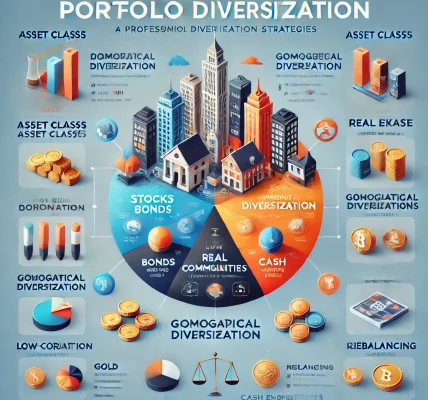Introduction
The stock market is an intricate financial system that operates based on a multitude of factors. Among these, economic indicators play a crucial role in influencing market trends and investor sentiment. These indicators provide insights into the health of an economy, helping investors make informed decisions. This blog explores the significance of economic indicators in stock market performance, their types, and how investors can leverage them to optimize their investment strategies.
Understanding Economic Indicators
Economic indicators are statistical data points that provide insight into the economic performance of a country. Governments, financial institutions, and independent organizations release these indicators at regular intervals. Investors, traders, and policymakers closely monitor these metrics to assess the state of the economy and predict future market trends.
Economic indicators are broadly classified into three categories:
- Leading Indicators – Predict future economic activity.
- Lagging Indicators – Confirm trends after they have been established.
- Coincident Indicators – Reflect current economic conditions.
Each category provides different insights, and a combination of these indicators helps market participants make informed investment decisions.
Key Economic Indicators and Their Impact on Stock Markets
1. Gross Domestic Product (GDP)
GDP measures the total economic output of a country. A growing GDP signifies a strong economy, leading to bullish stock markets. Conversely, a shrinking GDP signals economic distress, often causing market declines.
Impact on Stock Market:
- Positive GDP growth leads to increased corporate earnings and stock appreciation.
- Negative GDP growth may result in lower investor confidence and market downturns.
2. Unemployment Rate
The unemployment rate reflects the percentage of the labor force that is jobless and actively seeking employment. A high unemployment rate suggests economic weakness, whereas a low rate indicates economic stability.
Impact on Stock Market:
- Rising unemployment signals reduced consumer spending, potentially leading to bearish markets.
- Falling unemployment fosters economic growth, boosting stock prices.
3. Inflation Rate (Consumer Price Index – CPI)
Inflation represents the rate at which the general price level of goods and services rises over time. The Consumer Price Index (CPI) is a key metric for measuring inflation.
Impact on Stock Market:
- Moderate inflation supports economic growth, leading to stable markets.
- High inflation erodes purchasing power, leading to increased interest rates and potential stock market declines.
- Deflation, or negative inflation, can indicate economic stagnation, negatively impacting stocks.
4. Interest Rates (Federal Reserve Policy)
Central banks, such as the Federal Reserve (Fed), set interest rates to control economic stability. The Fed’s monetary policy decisions impact borrowing, spending, and investment.
Impact on Stock Market:
- Lower interest rates encourage borrowing and investing, leading to stock market gains.
- Higher interest rates make borrowing expensive, reducing corporate profits and stock valuations.
5. Consumer Confidence Index (CCI)
The Consumer Confidence Index gauges consumers’ optimism about the economy. Higher confidence results in increased spending and investment, while lower confidence leads to reduced economic activity.
Impact on Stock Market:
- A rising CCI reflects strong economic growth, boosting stock prices.
- A declining CCI may signal reduced consumer spending, negatively impacting markets.
6. Manufacturing and Industrial Production Data
Manufacturing activity and industrial production figures indicate the strength of the industrial sector. Rising production signals economic expansion, while declining figures suggest economic slowdown.
Impact on Stock Market:
- Positive growth in industrial production boosts stock prices in manufacturing-heavy industries.
- Declining production can signal economic troubles, negatively impacting stock performance.
7. Housing Market Indicators
Housing starts, building permits, and home sales reflect the health of the real estate market. A strong housing sector contributes to economic growth.
Impact on Stock Market:
- Increased home sales and construction activity benefit real estate and financial stocks.
- A weak housing market can signal economic contraction, leading to stock market losses.
8. Corporate Earnings Reports
Corporate earnings reports showcase a company’s profitability. These reports influence investor sentiment and stock valuations.
Impact on Stock Market:
- Strong earnings boost investor confidence, driving stock prices higher.
- Weak earnings reports lead to market sell-offs and stock price declines.
How Investors Can Use Economic Indicators
1. Monitoring Trends
Investors should track economic indicators regularly to identify market trends and potential investment opportunities.
2. Diversification
Diversifying a portfolio based on economic trends helps mitigate risk. For instance, during inflationary periods, investors may allocate assets to commodities and inflation-protected securities.
3. Adapting to Interest Rate Changes
Understanding interest rate trends allows investors to adjust their portfolios. Rising rates may prompt shifts toward bonds, while declining rates favor equities.
4. Utilizing Technical and Fundamental Analysis
Combining economic indicators with technical and fundamental analysis enhances investment decision-making. Investors should assess both macroeconomic trends and company-specific financials.
Conclusion
Economic indicators serve as essential tools for investors, traders, and policymakers to assess market conditions and make informed financial decisions. By closely analyzing GDP, unemployment rates, inflation, interest rates, and other key metrics, investors can navigate the complexities of the stock market with greater confidence.
Understanding the interplay between these indicators and market performance helps in building robust investment strategies, minimizing risks, and maximizing returns. As financial markets evolve, staying informed about economic trends will remain crucial for successful investing.




